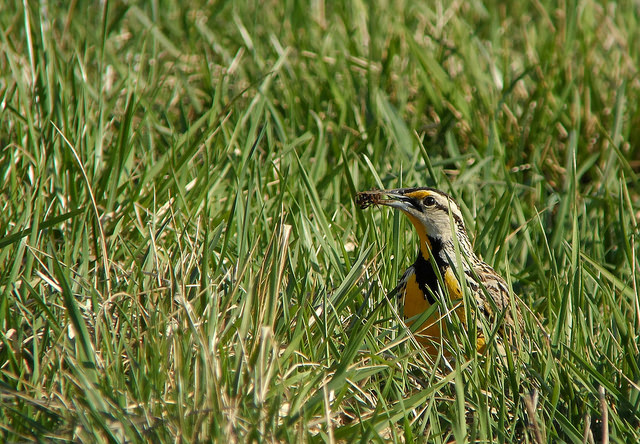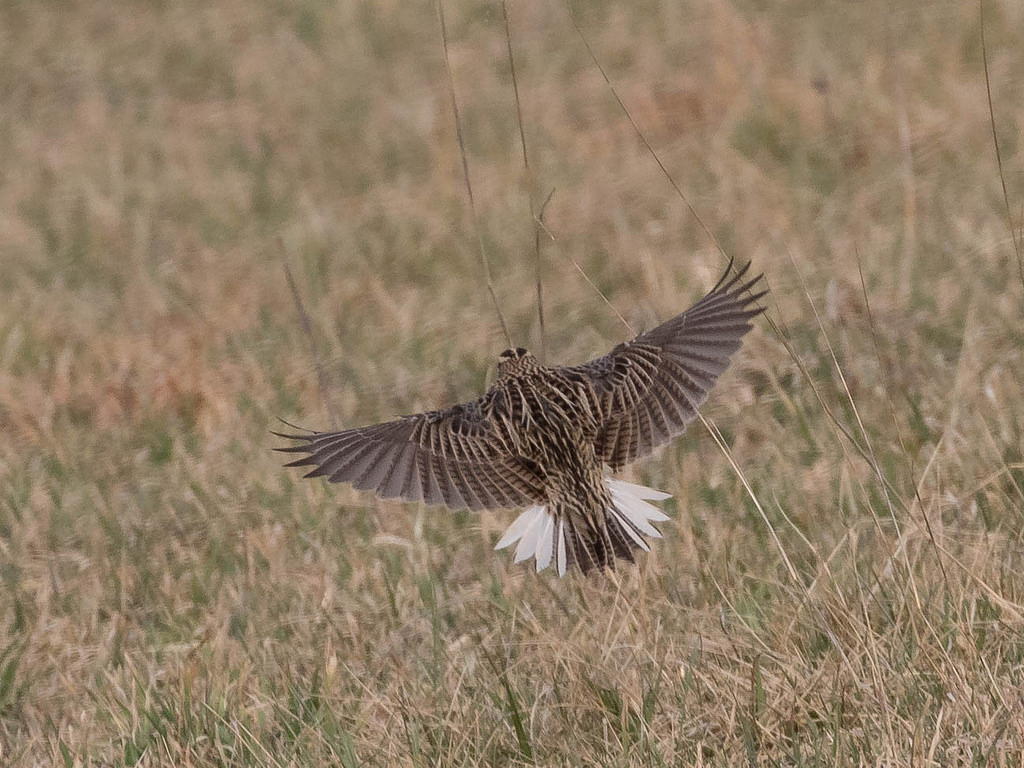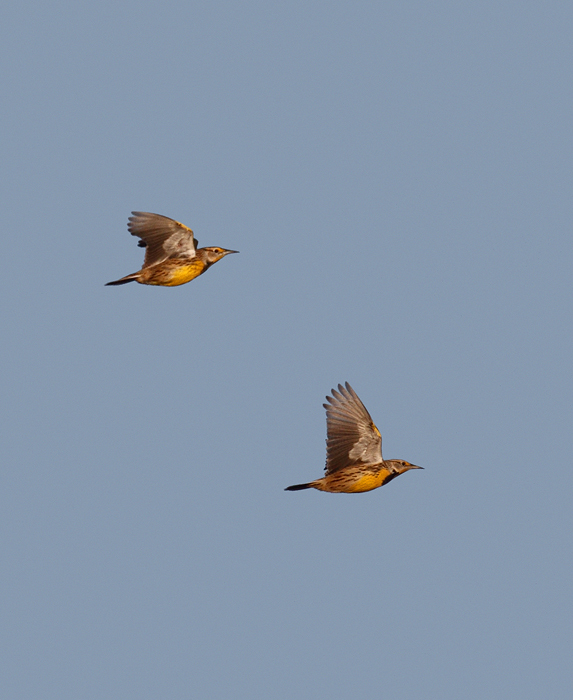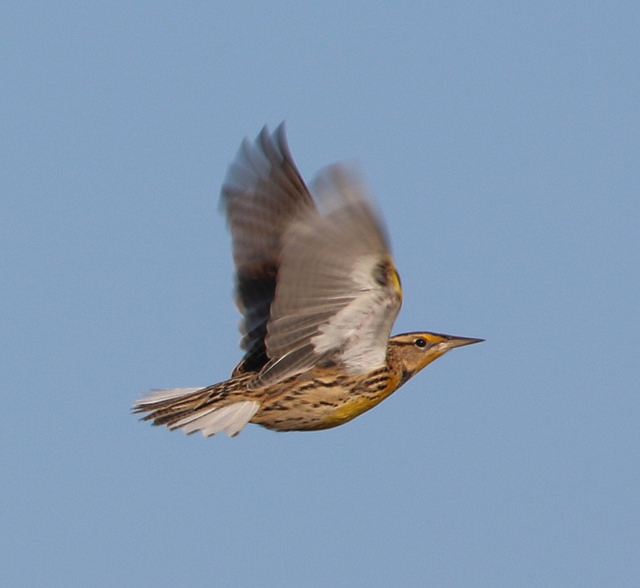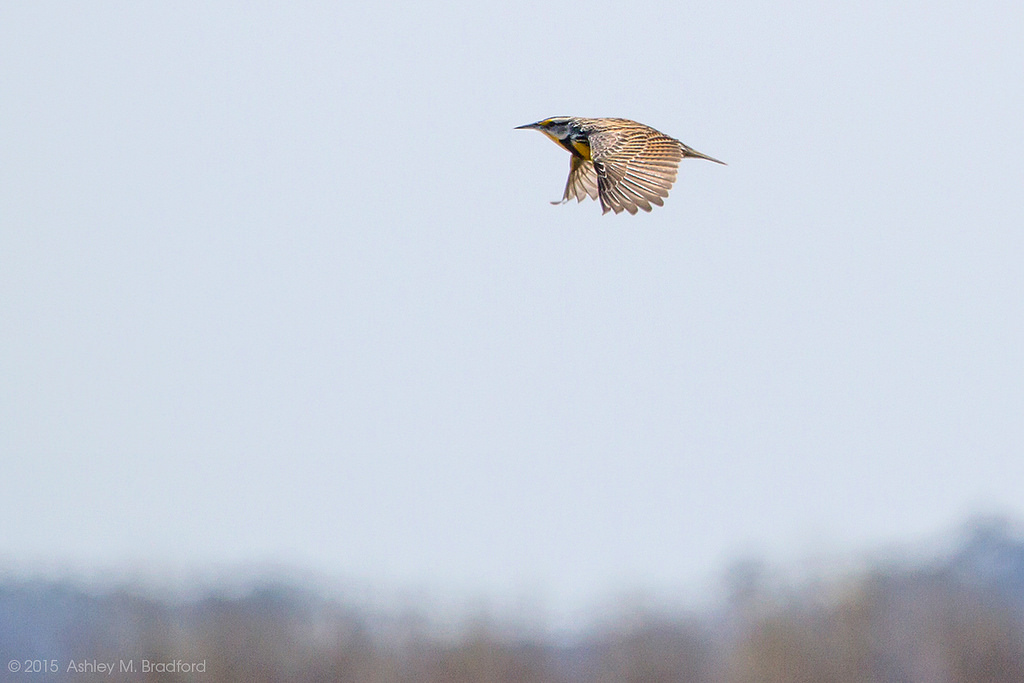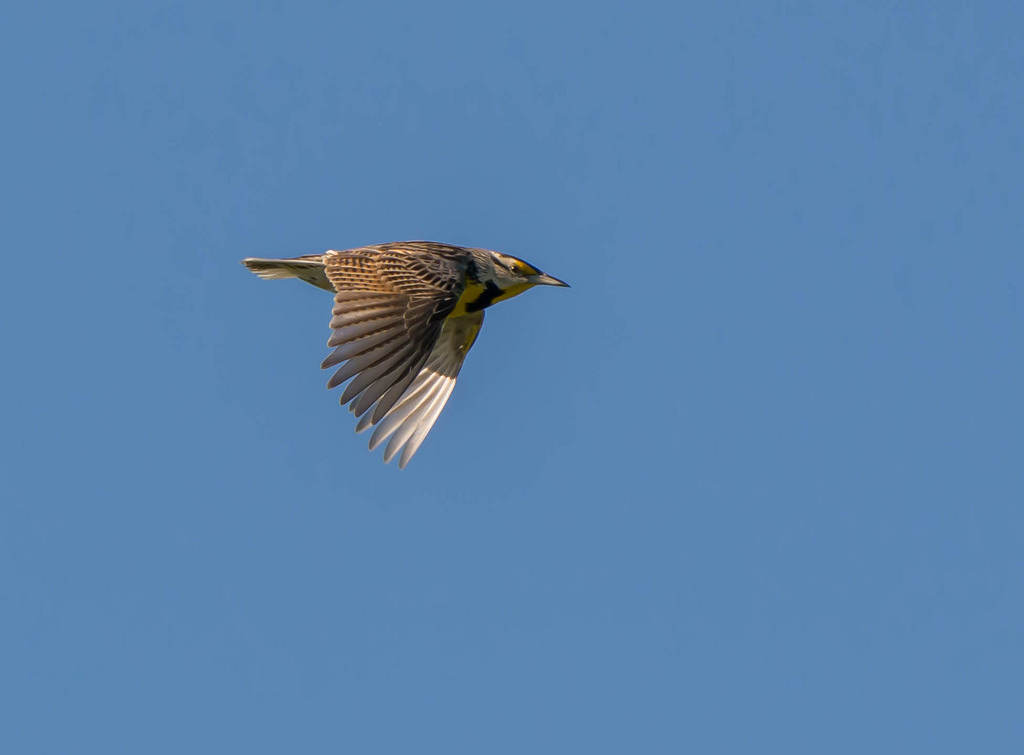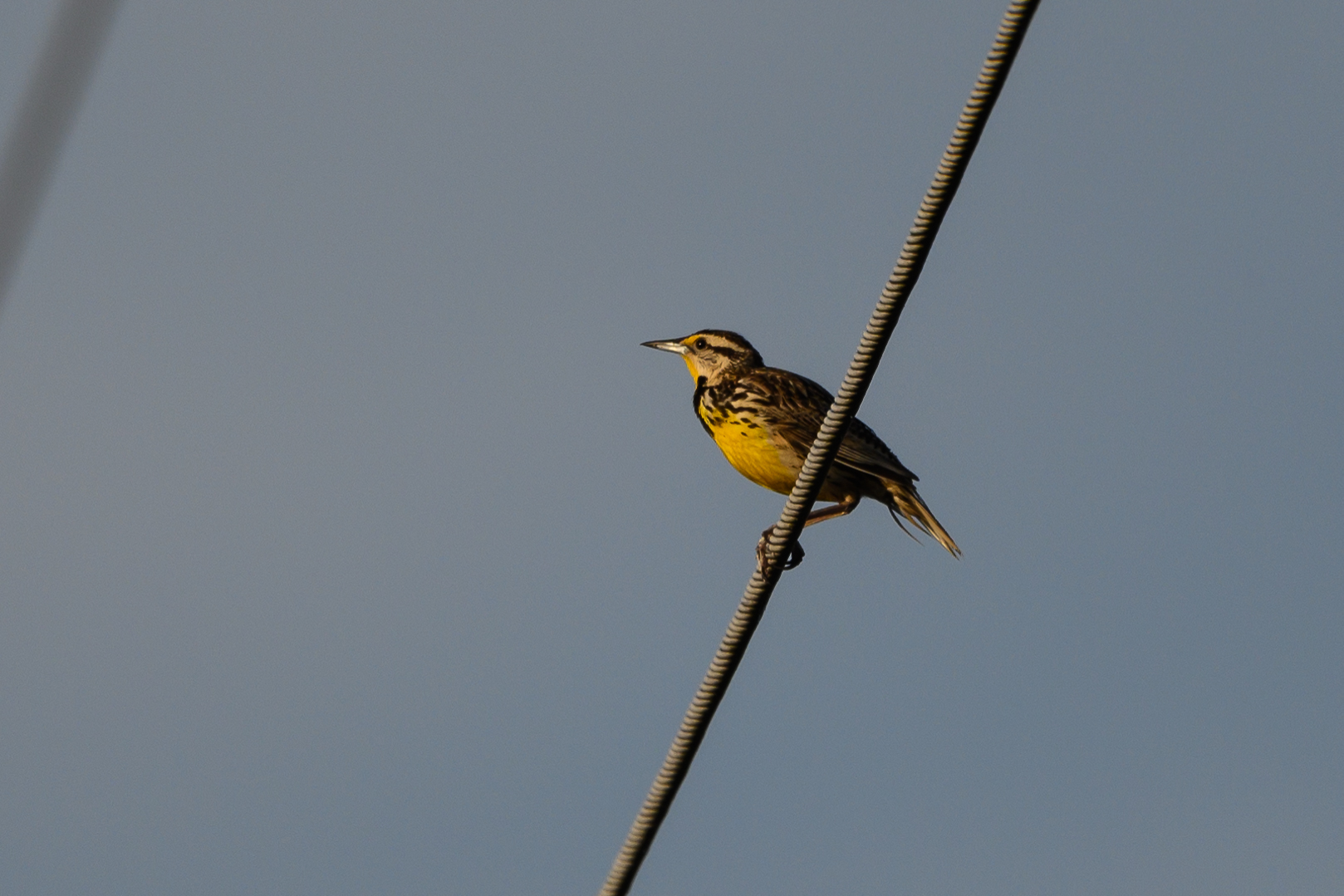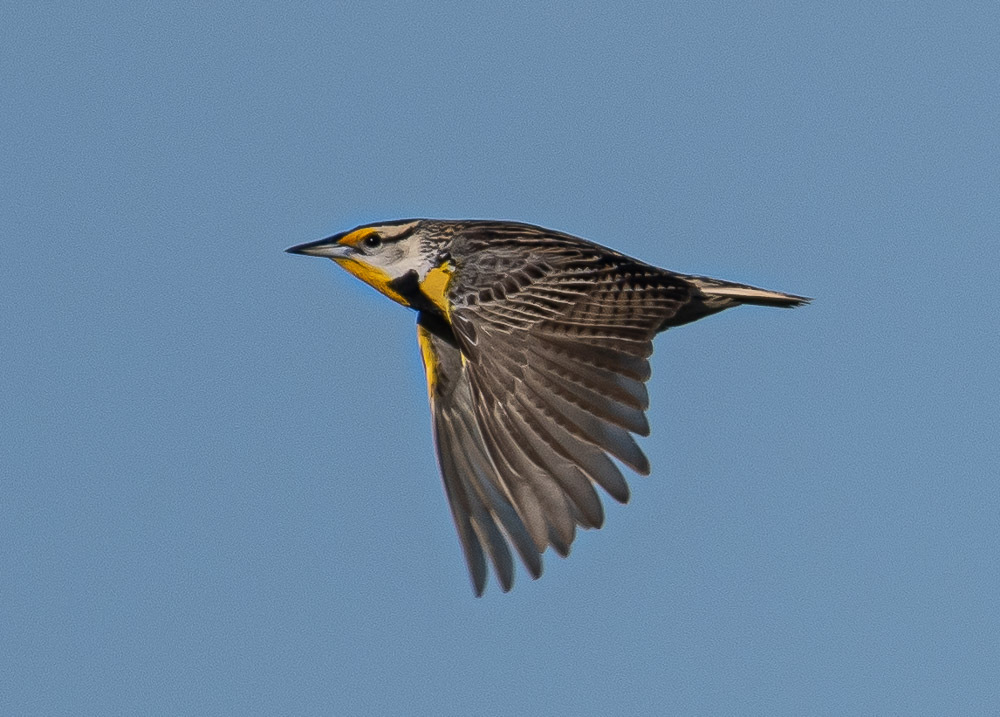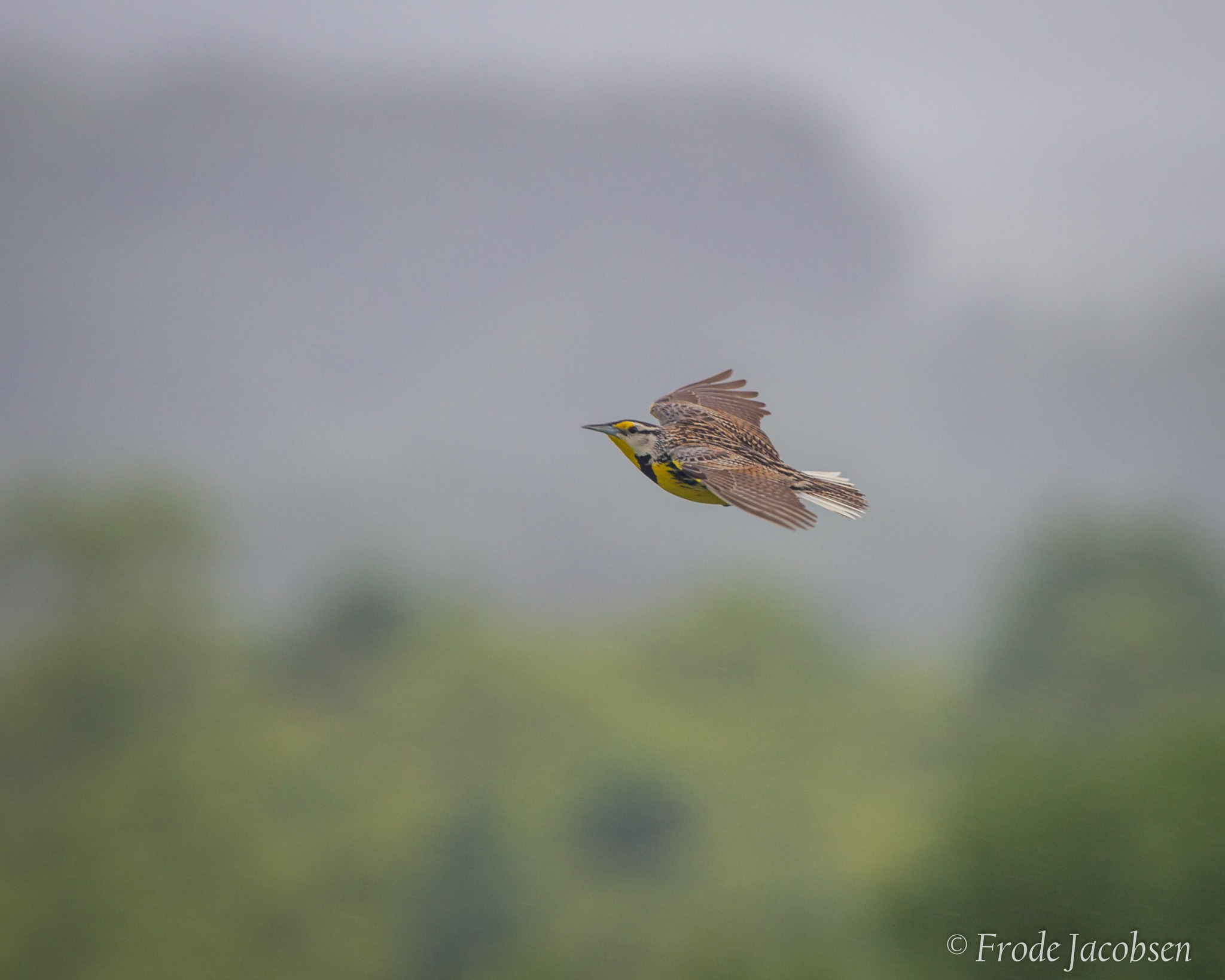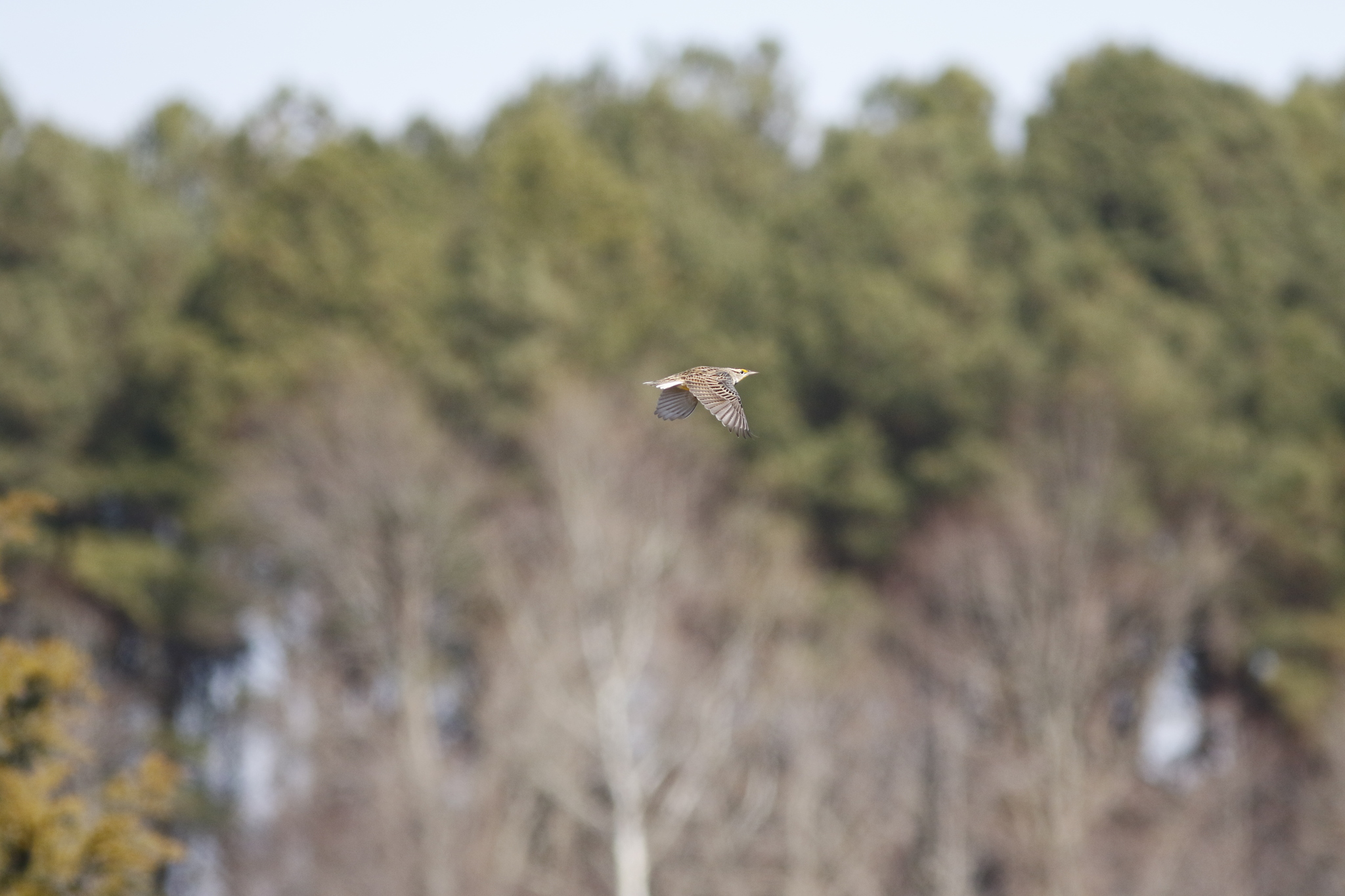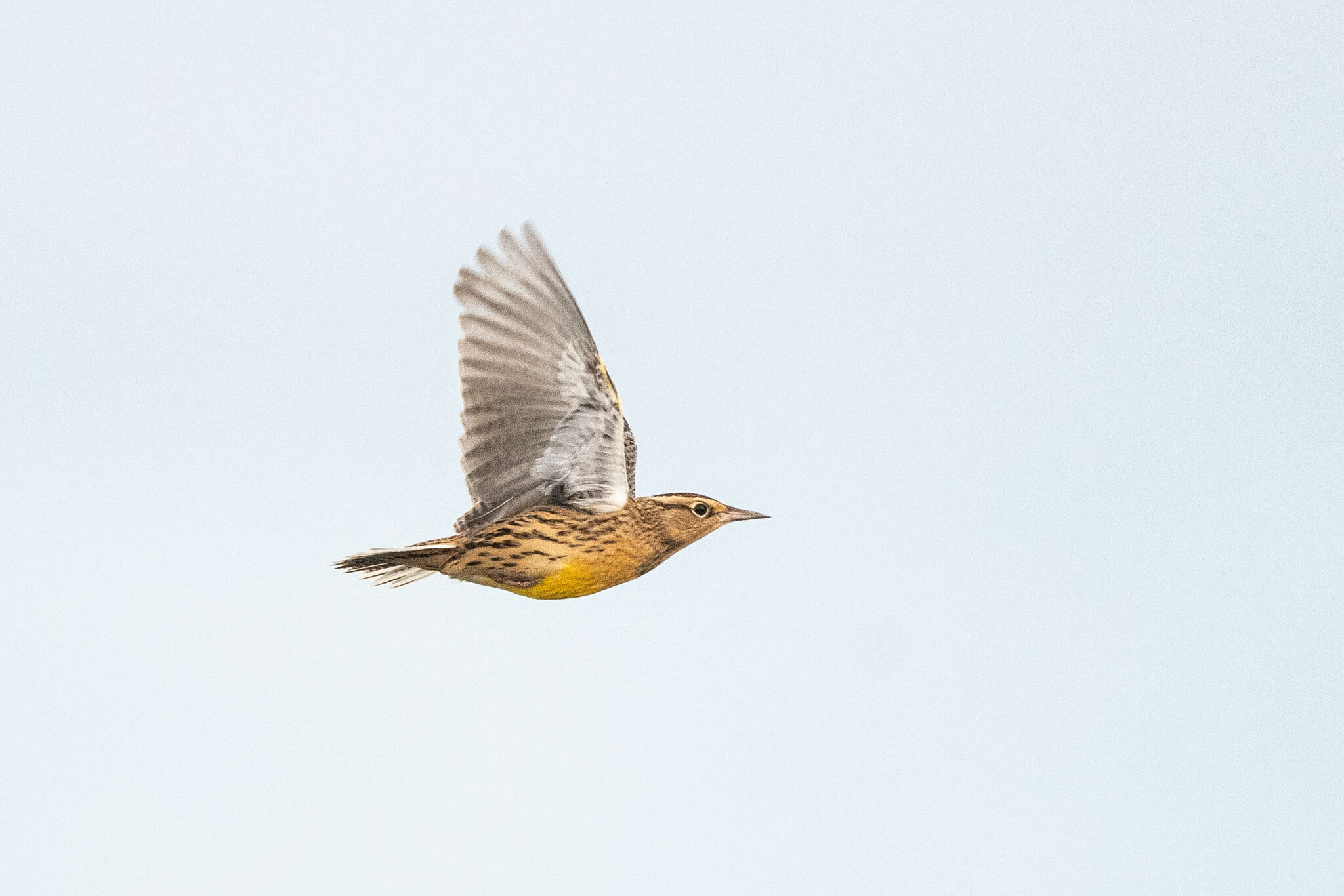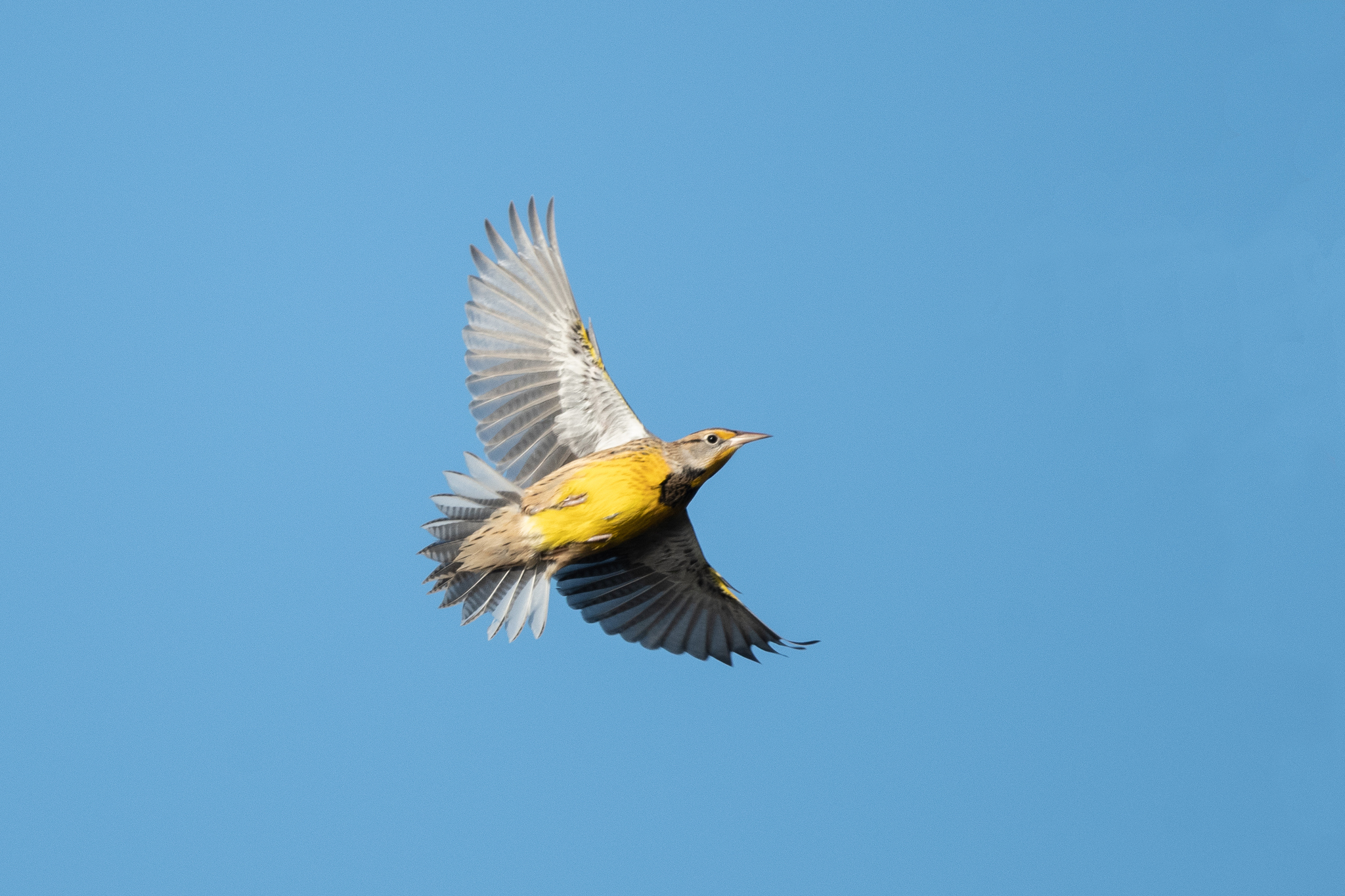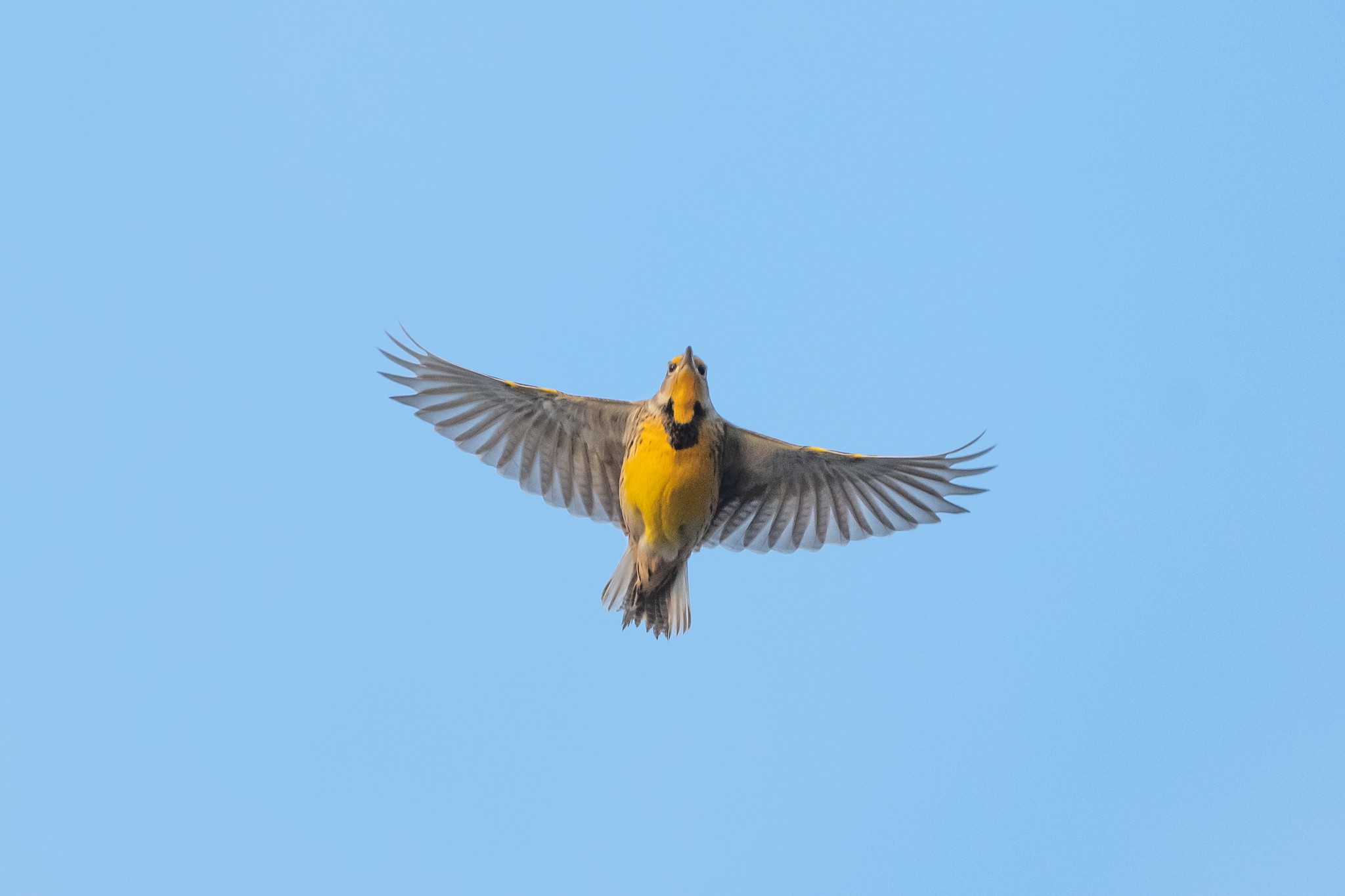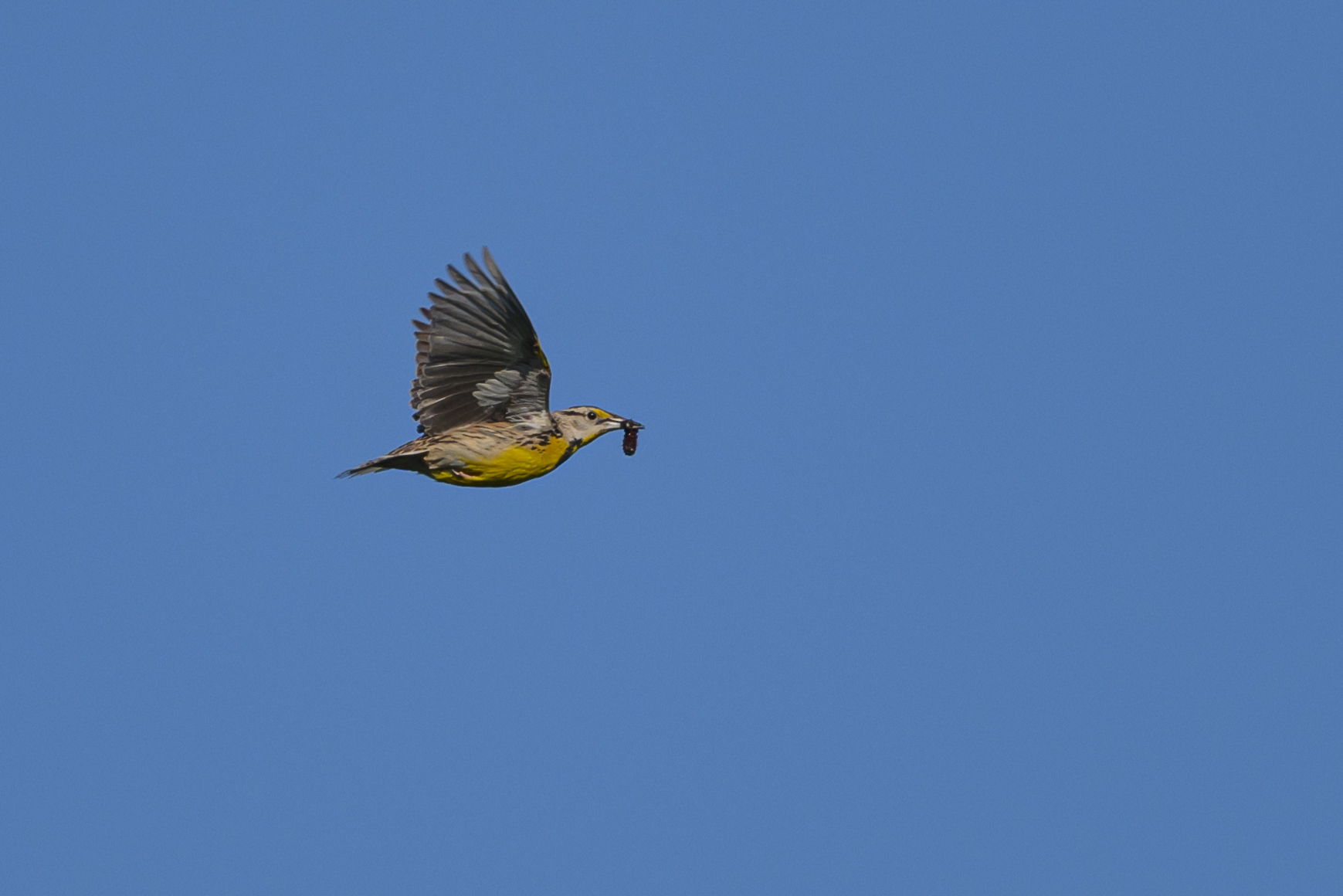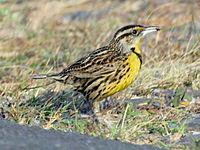Map Snapshot

























476 Records
Eastern Meadowlark in Montgomery Co., Maryland (6/8/2022). (c) Stephen John Davies, some rights reserved (CC BY-NC). - Stephen John Davies via iNaturalist.
Seasonality Snapshot
Source: Wikipedia
| Eastern meadowlark | |
|---|---|

| |
| S. m. mexicana Belize | |
| Song | |
| Scientific classification | |
| Domain: | Eukaryota |
| Kingdom: | Animalia |
| Phylum: | Chordata |
| Class: | Aves |
| Order: | Passeriformes |
| Family: | Icteridae |
| Genus: | Sturnella |
| Species: | S. magna
|
| Binomial name | |
| Sturnella magna | |

| |
| S. magna range Breeding range Year-round range
| |
| Synonyms | |
The eastern meadowlark (Sturnella magna) is a medium-sized blackbird (family: Icteridae), very similar in appearance to sister species western meadowlark. It occurs from eastern North America to northern South America, where it is also most widespread in the east. The Chihuahuan meadowlark was formerly considered to be conspecific with the eastern meadowlark.
Taxonomy
[edit]The eastern meadowlark was formally described by the Swedish naturalist Carl Linnaeus in 1758 in the tenth edition of his Systema Naturae. He placed it with the larks and pipits in the genus Alauda and adopted the binomial name Alauda magna.[2] Linnaeus based his description on the "large lark" that had been described and illustrated in 1729–1732 by the English naturalist Mark Catesby. Catesby also used the Latin Alauda magna but as his book predates the introduction of the binomial system, he is not acknowledged as the authority. Catesby reported that "they inhabit Carolina, Virginia and most of the Northern continent of America."[3] Confusingly, Linnaeus specified the habitat as "America, Africa".[2] The type location was restricted to South Carolina by the American Ornithologist's Union in 1931.[4][5] The eastern meadowlark is now placed with the western meadowlark and Chihuahuan meadowlark in the genus Sturnella that was introduced in 1816 by the French ornithologist Louis Pierre Vieillot.[6][7] The name Sturnella is a diminutive of the Latin sturnus meaning "starling".[8]
Fourteen subspecies are recognised:[7]
- S. m. magna (Linnaeus, 1758) – southeast Canada and central, east USA
- S. m. argutula Bangs, 1899 – south-central, southeast USA
- S. m. hoopesi Stone, 1897 – south Texas (south-central USA) and northeast Mexico
- S. m. saundersi Dickerman & Phillips, AR, 1970 – southeast Oaxaca (south Mexico)
- S. m. alticola Nelson, 1900 – south Mexico to Costa Rica
- S. m. mexicana Sclater, PL, 1861 – southeast Mexico to Belize and Guatemala
- S. m. griscomi Van Tyne & Trautman, 1941 – north Yucatán (southeast Mexico)
- S. m. inexspectata Ridgway, 1888 – Honduras and northeast Nicaragua
- S. m. subulata Griscom, 1934 – Panama
- S. m. meridionalis Sclater, PL, 1861 – north-central Colombia to northwest Venezuela
- S. m. paralios Bangs, 1901 – north Colombia and north, central Venezuela
- S. m. praticola Chubb, C, 1921 – llanos of east Colombia and southeast Venezuela to Guyana and Suriname
- S. m. monticola Chubb, C, 1921 – montane south Venezuela, the Guianas and north Brazil
- S. m. hippocrepis (Wagler, 1832) – Cuba
The list of subspecies formerly included S. m. lilianae and S. m. auropectoralis. These are now considered to be a separate species, the Chihuahuan meadowlark. The split was based on a study published in 2021 that showed that there were significant morphological, vocal and genomic differences between these two taxa and the other subspecies of the eastern meadowlark.[7][9][10]
Description
[edit]The adult eastern meadowlark measures from 19 to 28 cm (7.5 to 11.0 in) in length and spans 35–40 cm (14–16 in) across the wings.[11] Body mass ranges from 76 to 150 g (2.7 to 5.3 oz).[12][13] The extended wing bone measures 8.9–12.9 cm (3.5–5.1 in), the tail measures 5.3–8.6 cm (2.1–3.4 in), the culmen measures 2.8–3.7 cm (1.1–1.5 in) and the tarsus measures 3.6–4.7 cm (1.4–1.9 in). Females are smaller in all physical dimensions.[14] Adults have yellow underparts with a black "V" on the breast and white flanks with black streaks. The upperparts are mainly brown with black streaks. They have a long pointed bill; the head is striped with light brown and black.
The song of this bird is of pure, melancholy whistles, and thus simpler than the jumbled and flutey song of the western meadowlark; their ranges overlap across central North America. In the field, the song is often the easiest way to tell the two species apart, though plumage differences do exist, like tail pattern and malar coloration.
The pale Chihuahuan meadowlark of northern Mexico and the southwestern US is split off as a separate species.
Distribution and habitat
[edit]Their breeding habitat is grasslands and prairie, also pastures and hay fields. This species is a permanent resident throughout much of its range, though most northern birds migrate southwards in winter.[15] In 1993 this species was first recorded in El Salvador, and the discovery of a breeding pair in 2004 confirmed that the species is a resident there.[16]
Behavior and ecology
[edit]Breeding
[edit]Nesting occurs throughout the summer months. The nest is also on the ground, covered with a roof woven from grasses. There may be more than one nesting female in a male's territory. Nests are placed on the ground in depressions 1 to 3 inches deep, such as in the hoofprints of cattle, in pastures, meadows, hay fields, and on the edges of marshes. The nests are made of dried grass and plant stems, and are lined with grass lespedezas, pine needles, or horse hair.[17]

Food and feeding
[edit]These birds forage on the ground or in low vegetation, sometimes probing with the bill. They mainly eat arthropods, but also seeds and berries. In winter, they often feed in flocks. About three-quarters of the eastern meadowlark's diet is from animal sources like beetles, grasshoppers, and crickets. They also eat grain and seeds.[17]
Conservation status
[edit]The numbers of this species increased as forests were cleared in eastern North America. This species is ideally suited to farmland areas, especially where tall grasses are allowed to grow. Their numbers are now shrinking with a decline in suitable habitat.[18] On the other hand, its range is expanding in parts of Central America toward the Pacific (western) side of the continent, in agricultural-type areas.[16]
Eastern meadowlarks are species at risk in Nova Scotia and the subject of agricultural conservation program seeking to reduce mortality through modified practices.[19] Allowing marginal areas of fields on farms to seed with grass can provide nesting habitat for meadowlarks and all grassland birds. Delaying hay harvest can also improve survival, giving young meadowlarks a chance of fledging [20]
Gallery
[edit]-
Juvenile – Panama
-
Adult – Panama
-
Eggs of Sturnella magna MHNT
-
Juvenile and adult – Maine
References
[edit]- ^ BirdLife International (2020). "Sturnella magna". IUCN Red List of Threatened Species. 2020: e.T22735434A179984605. doi:10.2305/IUCN.UK.2020-3.RLTS.T22735434A179984605.en. Retrieved 11 November 2021.
- ^ a b Linnaeus, Carl (1758). Systema Naturae per regna tria naturae, secundum classes, ordines, genera, species, cum characteribus, differentiis, synonymis, locis (in Latin). Vol. 1 (10th ed.). Holmiae (Stockholm): Laurentii Salvii. p. 167.
- ^ Catesby, Mark (1729–1732). The Natural History of Carolina, Florida and the Bahama Islands (in English and French). Vol. 1. London: W. Innys and R. Manby. p. 33, Plate 33.
- ^ Committee on Classification and Nomenclature (1931). Check-list of North American Birds (4th ed.). Lancaster, Pennsylvania: American Ornithologist's Union. p. 301.
- ^ Paynter, Raymond A. Jr, ed. (1968). Check-List of Birds of the World. Vol. 14. Cambridge, Massachusetts: Museum of Comparative Zoology. p. 177.
- ^ Vieillot, Louis Pierre (1816). Analyse d'une Nouvelle Ornithologie Élémentaire (in French). Paris: Deterville/self. p. 34.
- ^ a b c Gill, Frank; Donsker, David; Rasmussen, Pamela, eds. (August 2022). "Oropendolas, orioles, blackbirds". IOC World Bird List Version 12.2. International Ornithologists' Union. Retrieved 27 August 2022.
- ^ Jobling, James A. (2010). The Helm Dictionary of Scientific Bird Names. London: Christopher Helm. p. 368. ISBN 978-1-4081-2501-4.
- ^ Beam, J.K.; Funk, E.R.; Taylor, S.A. (2021). "Genomic and acoustic differences separate Lilian's Meadowlark (Sturnella magna lilianae) from Eastern (S. magna) and Western (S. neglecta) meadowlarks". Ornithology. 138 (2): ukab004. doi:10.1093/ornithology/ukab004.
- ^ Chesser, R.T.; Billerman, S.M.; Burns, K.J.; Cicero, C.; Dunn, J.L.; Hernández-Baños, B.E.; Jiménez, R.A.; Kratter, A.W.; Mason, N.A.; Rasmussen, P.C.; Remsen, J.V.J.; Stotz, D.F.; Winker, K. (2022). "Sixty-third supplement to the American Ornithological Society's Check-list of North American Birds". Ornithology. 139 (3): ukac020. doi:10.1093/ornithology/ukac020.
- ^ "FieldGuides: Species Detail". eNature. Archived from the original on 2012-05-17. Retrieved 2013-04-01.
- ^ CRC Handbook of Avian Body Masses by John B. Dunning Jr. (Editor). CRC Press (1992), ISBN 978-0849342585.
- ^ "Eastern Meadowlark, Life History, All About Birds – Cornell Lab of Ornithology". Allaboutbirds.org. Retrieved 2013-04-01.
- ^ Jaramillo, Alvaro and Burke, Peter (1999) New World Blackbirds: The Icterids, Christopher Helm Publishing, ISBN 978-0713643336
- ^ Henninger, W.F. (1906). "A preliminary list of the birds of Seneca County, Ohio" (PDF). Wilson Bulletin. 18 (2): 47–60.
- ^ a b Herrera, Néstor; Rivera, Roberto; Ibarra Portillo, Ricardo & Rodríguez, Wilfredo (2006): Nuevos registros para la avifauna de El Salvador. ["New records for the avifauna of El Salvador"]. Boletín de la Sociedad Antioqueña de Ornitología 16 (2): 1–19. [Spanish with English abstract] PDF fulltext
- ^ a b Terres, John K. (1980). The Audubon Society Encyclopedia of North American Birds. New York: Alfred A. Knopf. p. 941.
- ^ "All About Birds: Eastern Meadowlark". Cornell Laboratory of Ornithology. Retrieved 2008-08-13.
- ^ "Eastern Meadowlark - Biodiversity Landowner Guide". Archived from the original on 2015-07-17. Retrieved 2015-07-16.
- ^ "Delay Haying - Biodiversity Landowner Guide". Archived from the original on 2015-07-17. Retrieved 2015-07-16.
External links
[edit]- "Eastern meadowlark media". Internet Bird Collection.
- Eastern meadowlark Bird Sound at Florida Museum of Natural History
- Eastern meadowlark photo gallery at VIREO (Drexel University)

